Dec 18, 2016 | charity, news, YN

As you know, I took on a project to fund a trip for the sixth grade class of Juniata Park Academy of Philadelphia so that they can visit the Philadelphia Mint and Federal Reserve Bank of Philadelphia to learn more about their money and how it plays into their everyday lives. I received a note from the DonorsChoose.org, the non-profit site the helped raise the funds, that Ms. Janas, the teacher at Juniata Park Academy, posted a note about the trip. She wrote:
Dear Scott,
We just completed our trip to the Federal Reserve and U.S. Mint on Friday. Even in the chilling temperatures, the enthusiasm was in full swing. One of the highlights of the trip was seeing all the money in both places we visited. Between coins and currency, the students were overwhelmed with how the coins originated, their artists and all the interactive activities that helped them understand how our money is made and all the safety measures that are taken to secure it. They could not believe that under the Federal Reserve Building were two vaults which each are the size of a football field.
They gave us samples of shredded currency at the Federal Reserve and we saw coins being processed in the U.S. Mint. Going through security screening was quite interesting because most of the students didn’t realize that any metal sets off the alarm and many alarms went off. It helped them understand how security works with government locations.
We will be going over our scavenger hunt that we completed at the Federal Reserve and additional information I received about the mint. Also this week one of our donors will be visiting our classroom to give us more hands on knowledge of coins. This was a great trip and we appreciate all of our donors giving us the opportunity to take this trip this year.
With gratitude,
Mrs. Janas
I am so excited for these kids and glad they got the opportunity to go to both places.
As promised, I will be visiting Juniata Park Academy. Aside from bringing pieces of my collection for them to see, I am also bringing gifts. After all, it is the holiday season! Since I will not be coming home right away, my cousin and I will be at the football game at Lincoln Financial Field (Go Big Blue!), I will report on my visit over the weekend.
UPDATE: Pictures were added to the original note at DonorsChoose.org. Go there to see them!
Oct 6, 2016 | charity, news, YN
 With many thanks to my readers and the numismatic community, the DonorsChoose.org campaign to fund the trip for Mrs. Janas of Juniata Park Academy class to visit the Philadelphia Mint and Federal Reserve has been funded!
With many thanks to my readers and the numismatic community, the DonorsChoose.org campaign to fund the trip for Mrs. Janas of Juniata Park Academy class to visit the Philadelphia Mint and Federal Reserve has been funded!
It will be a great experience for the class to be able to visit both the Mint and Fed.
I had previously contacted Mrs. Janas and offered to travel to Philadelphia to give her students a presentation about numismatics in daily life. Now that the project is funded, I will make the arrangement to visit her class to provide a more hands on the convergence between numismatics, math, and economics. I will bring some “gifts” for the class so that they can have in-hand examples.
There aren’t the words to express how thrilled I am that this project was funded.
Thank you!
Sep 29, 2016 | charity, Federal Reserve, news, US Mint, YN

Mrs. Janas of Juniata Park Academy in
Philadelphia, PA (Grades 6-8)
The project can be funded for a paltry sum of $512.92. With the donations matched by the Dottie Lutz Foundation, we can send underprivileged students to visit the Mint and the Fed for $256.46!
As I said in my original post, maybe a few would become interested in numismatics. Seeing the exhibits and learning how money is made can inspire these children to become collectors. And as inner-city students in a minority community, adding this diversity to the hobby is one of the best gifts we can give the hobby.
There is ONE MONTH to go on this project.
Previously, I asked to see if nine readers of the Coin Collectors Blog would step in with a $25.00 donation. Thankfully, it appears that only one person did step up. This effort now needs $413.00 to be funded meaning it will take is $206.50 in donations for this to be funded!
I am asking for everyone to
give any amount to fund this project.
It would be wonderful if the numismatic community stepped up to help fund the visits to the Mint and Fed for these students. Let’s see if we can influence some students to become numismatists.
Will you please join me?
Sep 25, 2016 | charity, commemorative, medals
 Toys for Tots is a charitable organization founded in 1947 by Major Bill Hendricks, a U.S. Marine Corps Reserve officer. MAJ Hendricks was inspired by his wife who wanted to donate a homemade Raggedy Ann doll to a needy child in the Los Angeles are but could not find an organization that could help. He organized other reservists and collected 5,000 toys to distribute in the Los Angeles area during the Christmas season.
Toys for Tots is a charitable organization founded in 1947 by Major Bill Hendricks, a U.S. Marine Corps Reserve officer. MAJ Hendricks was inspired by his wife who wanted to donate a homemade Raggedy Ann doll to a needy child in the Los Angeles are but could not find an organization that could help. He organized other reservists and collected 5,000 toys to distribute in the Los Angeles area during the Christmas season.
Although Toys for Tots has been only accepting new toys since 1980 because of the time to process used toys, every year the organization collects millions of toys to make Christmas brighter for children who would not otherwise receive toys. It is consistently rated one of the top charities in many different rankings and can boast one of the largest program to support services ratio. In 2015, Toys for Tots reported that only 3-percent of their monetary donations were used for administrative and support services.
Charities are trying to survive as donations have fallen since the Great Recession of 2008. Their balance sheets are getting better but many have not recovered to pre-recession levels. When they mail their letters asking for donation, most charities have added “prizes” to their request in order to get your attention. Some of the usual gimmicks have been address labels, stamps to mail back the donation, and some have added a nickel to the response form asking that it be returned with the donation. I have also received a lot of stickers and religious-based charms.
As a supporter of Toys for Tots, I recently received a request for donation. Rather than having any of the usual gimmicks a medal was attached to the request. Not an ordinary medal but a bronze medal for the Toys for Tots program. The 26mm medal (a quarter is 24.26mm) features the Toys for Tots logo on one side and the U.S. Marine Corps logo on the other. The 2mm thin (a quarter is 1.75mm) medal has an antiqued finish.
-
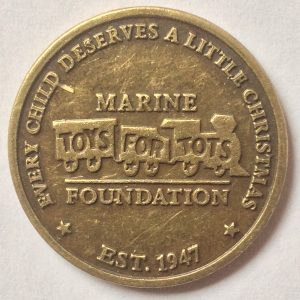
-
Tots for Tots Challenge Coin
-
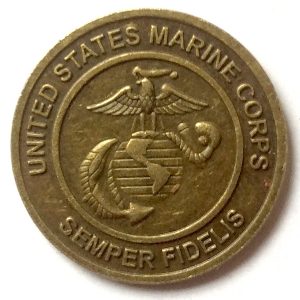
-
Tots for Tots Challenge Coin with Marine Corps Logo
A tradition of military organizations is the presenting of challenge coins. They are part of military tradition that started during World War I when Ivy League students went to war and created these coins as an act of camaraderie. Typically, a challenge coin is a small medal, usually no larger than 2-inches in diameter, with the insignia or emblem of the organization. Two-sided challenge coins may have the emblem of the service on the front and the back has the emblem of the division or other representative service. Challenge coins are traditionally given by a commander in recognition of special achievement or can be exchange as recognition for visiting an organization.
While the size of this Toys for Tots medal is smaller than the typical challenge coin, it can be considered a challenge coin. A challenge coin given by the Marine Foundation to their donors in recognition of the support of the organization.
I appreciate the recognition from the Marine Foundation and will continue to be a supporter for the Toys for Tots program.
Aug 16, 2016 | charity, news, YN
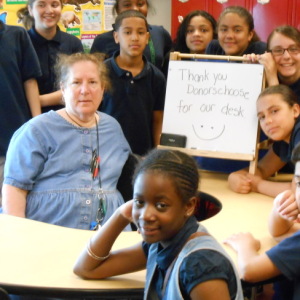 There are no bigger heroes in daily society than teachers.
There are no bigger heroes in daily society than teachers.
Teachers are entrusted with our children to teach them while working through the societal, social, and political issues to ensure that our future is educated. In the face of attack by people who think they know better and politicians who want them to do more with less, most teachers are dedicated individuals who are teaching for love. They cannot be doing it for the money because we misguidedly shortchange teachers who will use part of their meager salaries to buy supplies.
With the start of a new school year approaching, I would like to ask Coin Collectors Blog readers to help support a teacher in Philadelphia who is trying to raise money to take a field trip to the U.S. Mint and the Federal Reserve.
Mrs. Janas, a teacher at Juaniata Park Academy in Philadelphia, is trying to raise money to lease school busses to transport her students on these field trips. Her fundraiser says that her “students would love to expand their knowledge and be able to identify with the real world today and visit places around the area.” Visiting the Philadelphia Mint would be a great field trip!
The fundraiser is being hosted on a website called DonorsChoose.org. Those not familiar with the site, it was started in 2000 by a public school teacher without the resources to purchase books for his students. He built DonorChoose.org to bring together those who want to help with public school teachers who are trying to do their job with the little resources.
DonorsChoose.org is a 501(c)(3) not-for-profit corporation making all donation tax deductible to the maximum extent of the law. As part of the service, DonorsChoose.org has staff that vets every request and can work with the vendors to bring down prices. With some charities you worry about how much money is going to the project versus how much is being used in other fees. Not with DonorsChoose.org. On every project page they show you exactly where the money is spent. They are very transparent with their operations!
I learned about DonorsChoose.org several years ago and have tried to donate to at least one project every year.
Mrs. Janas is asking for $400 to lease the busses for the trips. Along with the other fees and a suggested 15-percent donation to DonorsChoose.org, the project can be funded for $512.92. However, donations to this project are being matched by Dottie Lutz, an advocate for education in the Philadelphia area. This project can be funded for a total of $256.46!
Aside that these children are the promise of our future, maybe a few would become interested in numismatics. Seeing the exhibits and learning how money is made can inspire these children to become collectors. And as inner-city students in a minority community, adding this diversity to the hobby is one of the best gifts we can give the hobby.
MY CHALLENGE
It will take at least nine readers of the Coin Collectors Blog with donations of $25.00 to fund this project after I make my donation. If my readers fund this project, I will contact Mrs. Janas and offer to travel to Philadelphia to give a presentation about numismatics in daily life to her students. Of course I will bring a few nicer items but the concentration will be on the convergence between numismatics, math, and economics.
UPDATE: I made my donation! I left a message on the page pointing to this post.
Will you please join me?
Sep 1, 2013 | ANA, books, charity, coins, education, personal, review
 Last year I reviewed The Official 2013 Blackbook Price Guide to United States Coins I received as an e-book from the publisher. In that review I was surprised as to the quality information that was in the book including articles that were written by numismatists sharing their expertise with the collecting public. Unfortunately, some of the information seemed dated and needed updating. Apparently the editors agreed and worked to update information.
Last year I reviewed The Official 2013 Blackbook Price Guide to United States Coins I received as an e-book from the publisher. In that review I was surprised as to the quality information that was in the book including articles that were written by numismatists sharing their expertise with the collecting public. Unfortunately, some of the information seemed dated and needed updating. Apparently the editors agreed and worked to update information.
Based on the review, the editors turned to a numismatist whose experience with computers, the Internet, and writing for the collector who could add the information about using technology to enhance the collecting experience.
This is where your favorite blogger enters the picture.
The Official 2014 Blackbook Price Guide to United States Coins has an new chapter, “Using Technology to Enhance Your Collecting Experience.” Written in plain language for the collector, the chapter discusses what numismatic-related resources are online.
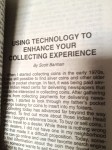 The chapter opens with a brief history of how computers and the Internet has advanced my collecting experiences. This includes a brief history of the Internet from its birth as ARPAnet through the invention of the birth of the World Wide Web and the services we now take for granted. I wrote it so that when you hear something Internet and web history in the news you have the background to understand why it is important.
The chapter opens with a brief history of how computers and the Internet has advanced my collecting experiences. This includes a brief history of the Internet from its birth as ARPAnet through the invention of the birth of the World Wide Web and the services we now take for granted. I wrote it so that when you hear something Internet and web history in the news you have the background to understand why it is important.
Following the introduction are sections that helps you find the information you want online. These sections are titled:
- Online Price Guides
- News and Blogs
- Mobile Computing
- E-books
- Social Media
- Buying and Selling Online
- Auctions (Established auction houses and their online options)
- Looking into the Future
- Your Security Online
If nothing else, the section “Your Security Online” may be worth the price of the book. It is something I have written in many forms, in many places, and have lectured about locally. These are general awareness tips that everyone should follow.
To their credit, the editors Mark Hudgeons, Tom Hudgeons Jr., and Tom Hudgeons Sr. read my review and updated the 52nd Edition of The Blackbook to address many of my concerns outside of my chapter. It is a better reference than in the past and worthy of a place in your numismatic library!
Autographs For Education
After autographing my first copy of the book I decided that rather than give away my autograph I want to use it to help raise money for numismatic education. For every autograph, I am asking for a minimum donation of $25 to the American Numismatic Association Florence Schook School of Numismatics to be used to further all numismatic education.
You can either mail the check yourself to the ANA and show me that you donated or give me the check and I will mail all of them together. Checks given to me should be made payable to the “American Numismatic Association” (NOT ME!) with a note on the memo line saying “For The Florence Schook School of Numismatics.”
For your donation, I will autograph the first page of my article above the title and give you recognition here on the blog. Since the ANA is a not-for-profit organization, your donations are tax deductible to maximum allowed by law.
One way to find out where I will be is to follow me here on the blog since I usually announce when I am going to a show. For planning purposes, I will attend the Virginia Numismatic Association Show on Saturday, September 28; the Pennsylvania Association of Numismatists show during October 24-26 (my attendance dates TBD) in Monroeville (a suburb of Pittsburgh); and the Whitman Baltimore Expo on Saturday, November 9. I might attend the Wall Street Coin, Currency and Collectibles Show in October if I can resolve a scheduling conflict.
Of course scheduling conflicts do arise, but let me know you if you will be looking for me at a show.
Post Script
Collectors of paper money, world coins, and stamps will be happy to know that the chapter will be adopted for the Blackbook covering those areas in 2015. I will also update the the current chapter since the online world has changed a little since it was written (e.g., Google shutdown the Reader service).
Book cover image courtesy of Random House.
Oct 31, 2012 | charity, currency, fun, history, pocket change
Before I begin with today’s post, to help the victims of Hurricane Sandy, I urge my readers to donate what they can to the American Red Cross. You can donate online or you can Text REDCROSS to 90999 to donate $10 to the Red Cross Disaster Relief fund. Charges will appear on your wireless bill, or be deducted from your prepaid balance.
Those of us in the D.C. metropolitan area dodged the wrath of Sandy for the most part. There are power outages, trees down, and flooding, but not to the extent north and east of here. It may take a day or two for what passes as normalcy to return to the area but we are in better shape than the coastal areas from the Delmarva Peninsula north to Connecticut and Rhode Island. I wish all of those in the effected areas well and hope their recovery goes as smoothly as possible.
Today’s post is lighter than planned. I rather than do a 2012 version of the numismatic trick or treat as I did last year, I will show off a pocket change find was not found in pocket change and not even change, per se. At our last coin club meeting someone paid for their auction lots with this Series 1953 $2 Federal Reserve Note. Although it is not in good shape and there is a tear in the bottom corner, I decided to take it as part of payment for the lots I sold.

Sec. George M. Humphrey
Thomas Edgar Stephens (1957)–Oil on canvas
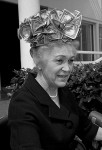
Priest Pictured with a hat of money when she announced her candidacy for treasurer of California (circa 1966)
Humphrey was the 55th Secretary of the Treasury serving during Eisenhower’s first term. It was reported that Humphrey gave up a $300,000 annual salary as president of the steel manufacturer M.A. Hanna Company to accept a Cabinet position that paid only $22,500. After retiring from government service, Humphrey returned to Hanna Company and later became chairman of National Steel Corporation.
Long time readers will remember that Priest was the mystery guest on the television game show “What’s my Line” that aired on August 29, 1954. If you forgot, you can go back and watch the video.
Aside from being a political leader in Utah and the 30th Treasurer of the United States, Priest is also the mother of Pat Priest who is better known for playing Marilyn Munster on the 1960’s sitcom “The Munsters.”

Pocket Change Find: Obverse of a Series 1953 $2 Federal Reserve Note signed by Treasurer Ivy Baker Priest and Secretary of the Treasury George M. Humphrey
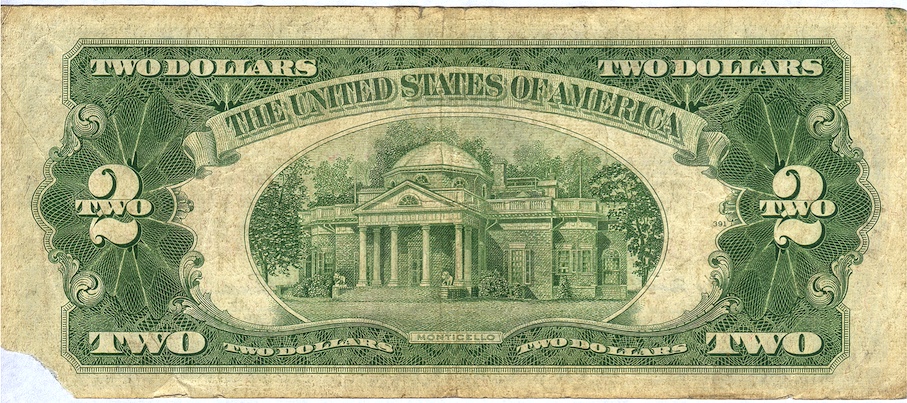
Pocket Change Find: Reverse of a Series 1953 $2 Federal Reserve Note featuring image of Jefferson’s Monticello.
Aug 24, 2012 | cents, charity, coins, fun
On a lighter note, after saving pocket change for nearly two years, I was able to fill a one galling container and an old beer pitcher. Using all the strength left in my aging arms, I carried the container and pitcher to the local bank that offers free coin counting for customers. Even though I am not a customer, my wife is and I deposited the results into her account to save money on the fees.
During the counting process, two of the bags in the machine filled and the teller had to replace them. But after a little more than a half-hour of feeding coins into the machine and checking the rejection bin, all the coins that were countable were counted and I came up with the following totals:
| Coin Type |
Quantity |
Value |
| Dollar coins |
18 |
$18.00 |
| Quarters |
1405 |
$351.25 |
| Dimes |
1247 |
$124.70 |
| Nickels |
793 |
$36.95 |
| Cents |
2108 |
$21.08 |
| Total |
$551.98 |
While I am not surprised that there were more cents than any other coins, I was a bit surprised as there were less than one thousand nickels. Over the next few days I carefully looked at the amount of change and figured out that most of the time, I am receiving quarters and dimes for most transactions ending with a 5. Change of 25, 35, and 45 cents does not require a nickel to be used while change of 55-cents adds a nickel to two quarter—of course I could have received 3 dimes and a quarter, but that was not the case while I was watching carefully.
Of 5,571 coins counted, 38-percent were the lowly Lincoln Cent that represented 3.8-percent of the total value. Although I still maintain that the United State should not end the coin’s production, seeing these results can lead to an interesting discussion. And before you do respond, an informal conversation at the Royal Canadian Mint during the World’s Fair of Money that they are delaying the buy back of their one-cent coins because of social issues brought up by merchants and many citizens. It appears that while many say they were for the elimination of the one-cent coin, when it really happened there are some significant objections being heard. We can discuss this further in the spring after the RCM begins their buy-back program.
There were several rejected coins including six wheat-back Lincoln cents from the 1950s. Somehow a steel cent ended up in the pile—but that may have happened when my cleaning people picked up a stray coin I may have dropped and added it to my pitcher. I also found several foreign coins including Canadian Cents (sorry, I am keeping those), two one-cent coins from Jamaica, a penny from the United Kingdom, a Canadian 5-cent coin, a 5 Eurocent coin with a French reverse, and two 1976 Bicentennial Quarters. There were also three buttons and a $1 note buried in the pitcher.
Proceeds are being donated to three different charities as well as being used for a nice dinner out with my wife. A special donation (on top of divided donation) of the $21.08 from the proceeds of the cents will be donated to Common Cents, creators of the Penny Harvest and the “Official Charity” of the Coin Collectors Blog.
Nov 7, 2010 | cents, charity, video
The Coin Collector’s Blog is a proud supporter of Common Cents®, an educational, not-for-profit organization, which specializes in creating and managing service-learning programs for young people. Their most popular and best known program is the . It is largest child philanthropy program in the United States.
This past fiscal year, Common Cents reported that “hundreds of thousands of students who participated in the Penny Harvest program last year, collecting and giving away $756,273.19 to charities.” For those who think the lowly copper-coated zinc cent is worthless, that is over 75 million coins collected by students in Metropolitan New York City, the New York Capital Region, Ohio, Florida, and Seattle to benefit causes around the world. In addition to charitable giving, the many of the students involved in the Penny Harvest participated in “service-learning projects, such as block clean-ups and literacy programs.”
I became interested in Common Cents when the Penny Harvest Field was set up in Rockefeller Center and featured on NBC Nightly News in 2007. Although I was unable to visit New York City to see this in person, it was quite a site on television. A year later after reading their annual report and talking with a teacher who was involved with the Penny Harvest, I made Common Cents the Official Charity of the Coin Collector’s Blog.
To better understand how lives can be touched not only by those receiving the help but by those working to provide the help, I found this video of Savion, a student from P.S. 163 Alfred E. Smith School, a multi-cultural school located on Manhattan’s upper west side.
As we approach the holiday season, I am asking my readers to please consider helping Common Cents with a donation to help them continue with the Penny Harvest. Also, if you live in an area where the Penny Harvest is not located, please consider getting involved and maybe start a Penny Harvest to your area. In fact, sign up for their mailing list and when you answer question 3 at the bottom of the page, click on at least one of the first three options and see if we can get the Penny Harvest working in more locations!
Charity is good for the soul!
Charity supported by children is not only good for the soul but a sign of a positive future for this nation.
Please support Common Cents and the Penny Harvest.
Videos courtesy of Common Cents.
May 21, 2009 | cents, charity, video
Anyone who has followed my writing knows that I am an advocate for keeping the Lincoln Cent and charities that use the cent as a basis for the good work they do. The power of the little copper-colored coin is underestimated and maligned for bogus reasons. The coin we colloquially (and incorrectly) call the penny deserves more respect.
Add Marcelo Bezos to the list of people who found the penny to be a worthy charitable endeavor. Bezos, the founder of the Penny Pyramid Project was inspired to break the world’s record for a pyramid made of cents by a family member’s ongoing fight with colorectal cancer. As Bezos writes, “My father in laws Dad has been battling this cancer for almost 12 years. In November of last year his health took a turn for the worst. I wanted to do something big to show this man that his strength, faith and will to live had touched many of those who had met him, including me.”
In turn, Bezos turned his project into an annual fundraising event in conjunction with students in his area.
The concept of building a pyramid from pennies is such a neat idea and the stop action video of the project is so cool, I thought my readers would be interested in watching:
If you watch this video, can someone please help me identify the background music?
Although his site and YouTube channel appears to be sporadically updated, I hope he is successful in furthering awareness to the necessity of screening and finding a cure for colorectal cancer.












